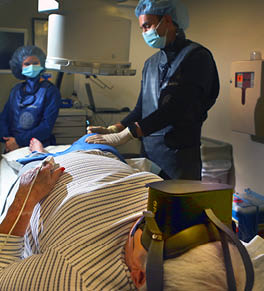Virtual reality eases pain

The last time Bonnie Carroll got an injection in her severely arthritic left knee, she found herself wandering peacefully through a wooded forest during the usually painful procedure thanks to virtual reality goggles.
Dr. Navid Alem, a UCI Health anesthesiologist and pain management specialist, and his colleagues at the UCI Health Center for Pain and Wellness have been using such 3D computer-generated programs with patients like Carroll to manage pain since 2019.
It is also used with patients in UCI Medical Center's burn intensive care unit and others receiving chemotherapy infusions.
“Instead of exposing patients to sedation, we have them wear virtual reality glasses to distract them from the pain,” Alem says. “They can immerse themselves in 60 different environments, from wandering through a garden, swimming with dolphins or walking the streets of London.”
Virtual reality (VR) is one more innovative way pain center specialists can manage their patients' discomfort and anxiety while still being able to communicate with them during procedures. “We’re always trying to find non-opioid methods to control pain,” Alem says. “This adds one more weapon to our arsenal.”
New paradigm for pain control
Virtual reality (VR) technology is shifting the paradigm of controlling pain with medications, particularly highly addictive drugs. As the cost of VR glasses and software programs have come down, this technology is increasingly being used in healthcare settings for a wide variety of applications.
Because her immune system is compromised by metastatic breast disease, Carroll isn’t a candidate for a knee replacement. Instead, she relies on treatments she receives from Alem at to alleviate her knee and back pain.
The Huntington Beach resident has used VR in combination with a local anesthetic for draining fluid from her knees and a more painful procedure called genicular nerve radiofrequency ablation, which blocks nerves in her knee. Alem and his colleagues are conducting a clinical study to evaluate VR’s effectiveness at reducing anxiety and pain in patients undergoing this procedure.
“While it doesn’t fully take away the pain, there is a definite difference in the magnitude,” says Carroll, 81, who retired a decade ago after serving as a director of medical education for the UCI School of Medicine.
How it works
VR is familiar to video gamers for immersing users in a computer-generated 3D environment, even giving them a virtual body to explore it. Research has shown its effectiveness during long procedures and for intense pain by engaging the brain in the artificial world.
VR works on multiple levels, redirecting the brain’s attention away from pain signals as the user explores in their virtual body and changing the user’s perception of time, according to a recently published analysis of existing research.
It also permits guided biofeedback, allowing patients to control their respiratory rate and heart rate for optimal relaxation and anxiety reduction.
While VR is already widely used in pediatric hospitals and for preoperative anxiety, Alem’s study is among the first to evaluate VR’s effectiveness in patients with chronically elevated levels of pain. It already shows promise as a method to help this vulnerable population, says Dr. Shalini Shah, director of UCI Health Pain Management Services.
Preliminary study results show that patients who used VR technology experienced less peak pain, lower anxiety and greater satisfaction than those who didn’t. Last November, the study abstract received the Presidential Award from the American Society of Regional Anesthesia and Pain Medicine (ASRA).
That same month, the U.S. Food and Drug Administration (FDA) authorized the marketing of EaseVRx — the VR system used at UCI Health — to help reduce chronic back pain in patients ages 18 and older. The system includes a controller and a headset that is designed to help regulate breathing and bring the virtual world to life.
Expanding VR use
Alem and his colleagues offer the VR system for outpatient procedures such as knee or shoulder injections and it is available on request for many others. They find it especially helpful with anxious patients.
“Unlike watching TV," he says, "the patient is immersed in an environment. They look up and see a bird flying; they look down and see flowers growing on the ground.”
Alem also is championing efforts to implement this leading-edge technology throughout the UCI Health system. Eventually, it may become available to expectant mothers during labor and delivery and to a host of other patients in need of pain management.
“Virtual reality is very patient-centric,” he says. “Imagine being a child getting a chemotherapy infusion while being able to swim with whales and dolphins or play a game.”
For the physicians at the Pain and Wellness Center, it’s all about finding new and better ways to minimize their patients’ pain and anxiety, Alem says. “At UCI Health, we really tailor our treatments for each patient.”
Carroll, for one, is glad they do. “I want to continue using virtual reality because it works for me.”






